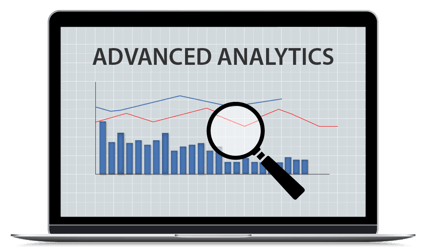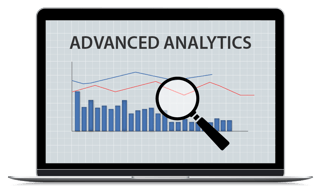Advanced Analytics As A Competitive Advantage
Nick Ostdick - July 18, 2017

 Competition. More so than ever before, today’s manufacturing companies are facing increasingly intense competition in an ever-expanding global marketplace. With new and emerging markets coming online in disparate parts of the globe, today’s manufacturing and supply network is growing more diverse, complex, and intertwined, and manufacturing companies need more powerful, integrated, and intelligent solutions to cut this complexity and maintain the efficacy of their planning and production programs.
Competition. More so than ever before, today’s manufacturing companies are facing increasingly intense competition in an ever-expanding global marketplace. With new and emerging markets coming online in disparate parts of the globe, today’s manufacturing and supply network is growing more diverse, complex, and intertwined, and manufacturing companies need more powerful, integrated, and intelligent solutions to cut this complexity and maintain the efficacy of their planning and production programs.
Enter advanced analytics and its ability to give manufacturing companies the insight and visibility into their overall supply and production platforms. With an endgame of helping manufacturing companies analyze and sort data, streamline processes, and increase the efficiency of planning and production programs, advanced analytics is a critical value proposition in a variant-rich industry where network partners operate at numerous disparate points across the globe. Because advanced analytics relies in large part on the adoption of intelligent technologies or solutions like Industry 4.0, Big Data, and The Internet of Things (IOT), planners and managers have the ability to put large amounts of data and reporting to work to leverage lean manufacturing principles for greater derived value.
Yet, many manufacturing companies still don’t realize the full potential of advanced analytics as a critical tool in leveraging a competitive advantage in a crowded marketplace. This of course begs the question: How exactly can companies conceive of advanced analytics as a competitive advantage? What benefits can advanced analytics provide today’s manufacturing companies? These are important questions companies must ask themselves when weighing how to integrate and deploy advanced analytics as part of their planning and production platform.
Optimized decision-making
Many processes in an optimized supply chain rely on a balance of automation and human intervention at both the conceptual and execution level. While some events such as partnering with suppliers or interacting with workers may in fact benefit from human intervention, issues such as replenishment or facility or machine allocation are better suited for advanced analytics for planners to make the most cost-effective, efficient decisions. Advanced analytics makes it possible for planners and managers to know well ahead of time when additional inventory may be needed to maintain delivery timetables or combat production bottlenecks due to new constraints in production programs.
Advanced analytic capabilities allow planners to then deploy the necessary container management strategies to ensure the right parts are on the production floor at the right time. Reducing the number of moves a company must make to ensure the fluidity of planned production programs is a core driver in decreasing operational costs and maximizing profitability.
Precise reporting and data gathering
Today’s global supply network relies heavily on the accuracy and efficacy of detailed reporting based on advanced metrics and criteria. Without these optimized reporting capabilities, manufacturing companies can find it difficult to create the accurate modeling and forecasting necessary to ensure more effective demand capacity planning and production programs. Through greater production control across a wide supply stream and enhanced capabilities to gather, sort, and collaborate on complex data sets, advanced analytics allows planners and managers to generate more accurate, detailed reports that foster more effective, precise modeling in future planning. The ability to better predict where you’re headed based on where you’ve been offers companies enhanced value in allocating the right resources and materials for given production programs.
Real-time supply and production feedback
Advanced analytics essentially gives manufacturing companies an “in-the-moment” window into their current supply situation in order to make adjustments or modifications for mid and long-term success. This real-time capability is critical in both the planning and production stages, but it’s also a key driver for companies in reducing instances of inventory overages or shortages, transportation or routing breakdowns, and other costly disruptions along the value chain. Avoiding these pitfalls should be a top priority for manufacturing companies in leveraging a lean, streamlined production philosophy where waste in the supply network is significantly reduced and best practices are optimized for the greatest possible business outcomes.
End-to-end (E2E) visibility
End-to-end (E2E) visibility for manufacturers is critical to truly understanding the nuances of their overall supply situation. By incorporating advanced analytics into the supply chain, planners and managers can gain real-time insight into current demand planning and production variables to make more informed decisions about how to best allocate materials, resources, and manpower to ensure on-time delivery and customer satisfaction. Advanced analytics allows for a more robust visualization and actualization of critical data as opposed to human or manual intervention, which can often result in long lead times before such data can be optimized to enhance supply chain efficiency.
Advanced analytics also allows organizations to extend E2E visibility upstream to suppliers and downstream to end users. As advanced analytics are shared beyond the boundaries of an organization, the supply chain achieves a new level of E2E visibility and agility, both of which are important elements in reducing operational costs and increasing revenues.
LATEST POSTS
- Understand Circular Economy in The Manufacturing Industry
- How Can Industry 4.0 IT Integration Be Achieved Smoothly?
- The Significance of Order Sequencing in Discrete Manufacturing
- How to improve your Supply Chain Management: The Power of Control Towers
- Optimizing Human Resource Scheduling in Manufacturing: A Technological Approach



